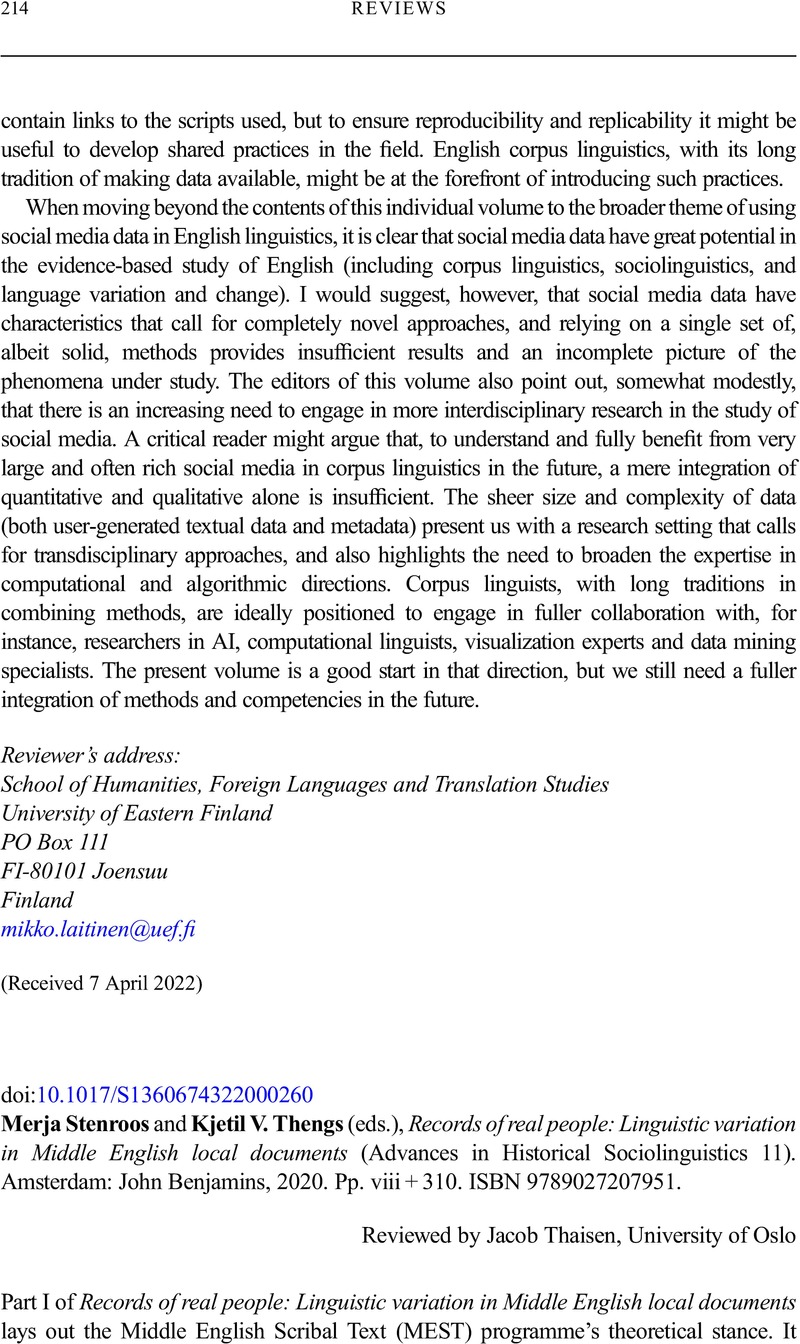No CrossRef data available.
Article contents
Merja Stenroos and Kjetil V. Thengs (eds.), Records of real people: Linguistic variation in Middle English local documents (Advances in Historical Sociolinguistics 11). Amsterdam: John Benjamins, 2020. Pp. viii + 310. ISBN 9789027207951.
Review products
Merja Stenroos and Kjetil V. Thengs (eds.), Records of real people: Linguistic variation in Middle English local documents (Advances in Historical Sociolinguistics 11). Amsterdam: John Benjamins, 2020. Pp. viii + 310. ISBN 9789027207951.
Published online by Cambridge University Press: 28 September 2022
Abstract
An abstract is not available for this content so a preview has been provided. Please use the Get access link above for information on how to access this content.

- Type
- Book Review
- Information
- Copyright
- Copyright © The Author(s), 2022. Published by Cambridge University Press
References
Benskin, Michael. 1988. The numerical classification of languages, and dialect maps for the past. In Reenen, Pieter van & Reenen-Stein, Karen van (eds.), Distributions spatiales et temporelles, constellations des manuscrits, 13–38. Amsterdam: John Benjamins.CrossRefGoogle Scholar
Benskin, Michael. 1994. Descriptions of dialect and areal distributions. In Laing, Margaret & Williamson, Keith (eds.), Speaking in our tongues: Medieval dialectology and related disciplines, 169–87. Woodbridge: D. S. Brewer.Google Scholar
Conde-Silvestre, Juan Camilo. 2021. Review of Stenroos, Merja & Thengs, Kjetil V. (eds.), Records of real people: Linguistic variation in Middle English local documents. https://linguistlist.org/issues/32.3987 (accessed 12 July 2022).Google Scholar
Gordon, Moragh. 2017. The urban vernacular of late medieval and Renaissance Bristol. PhD dissertation, Utrecht University.Google Scholar
Hernández-Campoy, Juan Manuel & Conde-Silvestre, Juan Camilo. 2015. Assessing variability and change in early English letters. In Auer, Anita, Schreier, Daniel & Watts, Richard J. (eds.), Letter writing and language change, 15–34. Cambridge: Cambridge University Press.Google Scholar
McIntosh, Angus, Samuels, Michael & Benskin, Michael (eds.). 1986. A Linguistic Atlas of Late Mediaeval English. Aberdeen: Aberdeen University Press.Google Scholar
Thaisen, Jacob. 2019. The round allograph of <r> in late Middle English. Studia Anglica Posnaniensia 53, 129–44.CrossRefGoogle Scholar
Wray, Alison. 2008. Formulaic language: Pushing the boundaries. Oxford: Oxford University Press.Google Scholar



